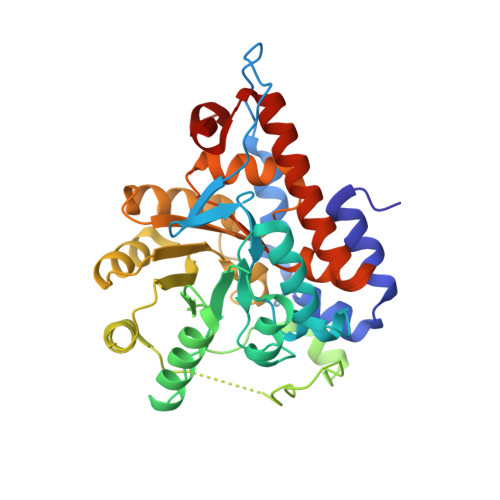Crystal Structure Analysis of Recombinant Rat Kidney Long Chain Hydroxy Acid Oxidase.
Cunane, L.M., Barton, J.D., Chen, Z.W., Le, K.H.D., Amar, D., Lederer, F., Mathews, F.S.(2005) Biochemistry 44: 1521-1531
- PubMed: 15683236
- DOI: https://doi.org/10.1021/bi048616e
- Primary Citation of Related Structures:
1TB3 - PubMed Abstract:
Long chain hydroxy acid oxidase (LCHAO) is a member of an FMN-dependent enzyme family that oxidizes L-2-hydroxy acids to ketoacids. LCHAO is a peroxisomal enzyme, and the identity of its physiological substrate is unclear. Mandelate is the most efficient substrate known and is commonly used in the test tube. LCHAO differs from most family members in that one of the otherwise invariant active site residues is a phenylalanine (Phe23) instead of a tyrosine. We now report the crystal structure of LCHAO. It shows the same beta8alpha8 TIM barrel structure as other structurally characterized family members, e.g., spinach glycolate oxidase (GOX) and the electron transferases yeast flavocytochrome b2 (FCB2) and Pseudomonas putida mandelate dehydrogenase (MDH). Loop 4, which is mobile in other family members, is visible in part. An acetate ion is present in the active site. The flavin interacts with the protein in the same way as in the electron transferases, and not as in GOX, an unexpected observation. An interpretation is proposed to explain this difference between GOX on one hand and FCB2 and LCHAO on the other hand, which had been proposed to arise from the differences between family members in their reactivity with oxygen. A comparison of models of the substrate bound to various published structures suggests that the very different reactivity with mandelate of LCHAO, GOX, FCB2, and MDH cannot be rationalized by a hydride transfer mechanism.
Organizational Affiliation:
Department of Biochemistry and Molecular Biophysics, Washington University School of Medicine, St. Louis, Missouri 63110, USA.
















